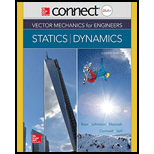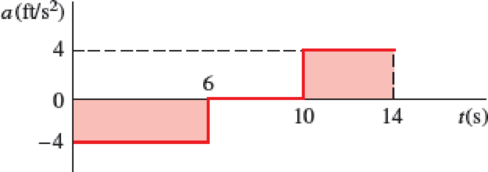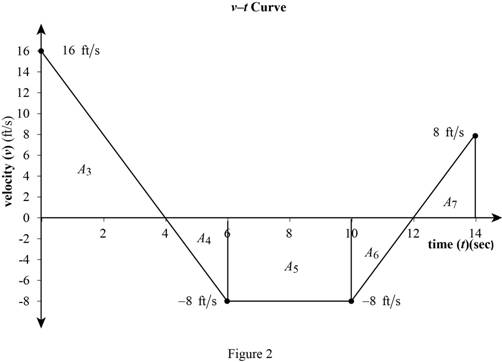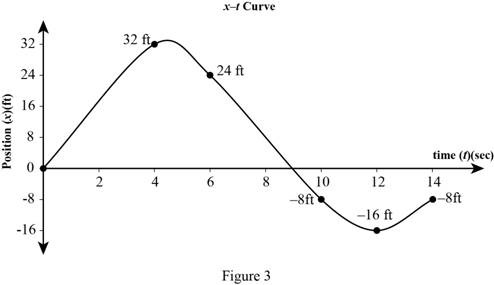
Concept explainers
A particle moves in a straight line with a constant acceleration of −4 ft/s2 for 6 s, zero acceleration for the next 4 s, and a constant acceleration of +4 ft/s2 for the next 4 s. Knowing that the particle starts from the origin and that its velocity is −8 ft/s during the zero acceleration time interval, (a) construct the v−t and x−t curves for 0 ≤ t ≤ 14 s, (b) determine the position and the velocity of the particle and the total distance traveled when t = 14 s.
Fig. P11.61 and P11.62

(a)
Construct the
Explanation of Solution
Given information:
The constant acceleration
The acceleration is zero from 6sec to 10 sec.
From 10 sec to 14 sec the acceleration
The velocity
Calculation:
Show a-t curve of particle that moves in a straight line as in Figure (1).

Calculate the area
Substitute 6 sec for
Calculate the area
Substitute 4 sec for
Calculate the velocity
Substitute
Calculate the velocity
Substitute
Calculate the velocity
Substitute
Tabulated the acceleration (a), velocity (v) corresponding to time (t) in Table (1) :
| t(s) | ||
| 0 | -4 | 16 |
| 6 | 0 | -8 |
| 10 | 0 | -8 |
| 14 | 4 | 8 |
Plot the v-t curve of particle that moves in a straight line with areas as in Figure (2).

Calculate the area
Here,
Substitute 4 sec for
Calculate the area
Here,
Substitute 2 sec for
Calculate the area
Here,
Substitute 4 sec for
Calculate the area
Here,
Substitute 2 sec for
Calculate the area
Here,
Substitute 4 sec for
Calculate the position
Calculate the position
Substitute 0 for
Calculate the position
Substitute
Calculate the position
Substitute
Calculate the position
Substitute
Calculate the position
Substitute
Tabulated the position (x) corresponding to time (t) in Table 2:
| t (sec) | x (ft) |
| 0 | 0 |
| 4 | 32 |
| 6 | 24 |
| 10 | -8 |
| 12 | -16 |
| 14 | -8 |
Plot x-t curve of particle that moves in a straight line with areas as in Figure 3.

(b)
The position, velocity of the particle and the total distance (d) traveled when time (t) 14 sec.
Answer to Problem 11.61P
The total distance (d) traveled when time (t) 14 sec is
Explanation of Solution
Given information:
The constant acceleration
The acceleration is zero from 6sec to 10 sec.
From 10 sec to 14 sec the acceleration
The velocity
Calculation:
Calculate the area
Substitute 6 sec for
Calculate the area
Substitute 4 sec for
Calculate the velocity
Substitute
Calculate the velocity
Substitute
Calculate the velocity
Substitute
Calculate the area
Here,
Substitute 4 sec for
Calculate the area
Here,
Substitute 2 sec for
Calculate the area
Here,
Substitute 4 sec for
Calculate the area
Here,
Substitute 2 sec for
Calculate the area
Here,
Substitute 4 sec for
Calculate the position
Calculate the position
Substitute 0 for
Calculate the position
Substitute
Calculate the position
Substitute
Calculate the position
Substitute
Calculate the position
Substitute
Calculate the distance
Substitute 0 for
Calculate the distance
Substitute
Calculate the distance
Substitute
Calculate the total distance (d) traveled when time (t) is 14 sec
Substitute
Therefore, the total distance (d) traveled when time (t) 14 sec is
Want to see more full solutions like this?
Chapter 11 Solutions
Connect 2 Semester Access Card for Vector Mechanics for Engineers: Statics and Dynamics
- A particle moves in a straight line with a constant acceleration of 2.2 m/s2for 6s, zero acceleration for the next 5s, and a constant decceleration of 1.25 m/s2for 4s. Knowing that the particle starts from the origin and that its velocity is 17.55 m/s during the zero acceleration time interval . Determine the distance travelled (in meters) by the particle after 6 seconds.arrow_forwardA particle is moving along a straight line such that its position is defined by s = (10t^2 + 20) mm, where t is in seconds. Determine (a) the displacement of the particle during the time interval from t = 1 s to t = 5 s, (b) the average velocity of the particle during this time interval, and (c) the acceleration when t = 1 s.arrow_forwardA particle moves in a straight line with a constant acceleration of 2.02 m/s^2for 6s, zero acceleration for the next 5s, and a constant decceleration of 1.3 m/s^2for 4s. Knowing that the particle starts from the origin and that its velocity is 17.09 m/s during the zero acceleration time interval . Determine the distance travelled (in meters) by the particle after 6 seconds. Round off only on the final answer expressed in three decimal places.arrow_forward
- A particle is moving along a straight line such that its position from a fixed point is s = (12 – 15t2 + 5t3) m, where t is in seconds. Determine the average speed of the particle, What is the average acceleration of the particle, Determine the total distance traveled by the particle from t = 1 s to t = 3 sarrow_forwardA particle is moving along a straight line such that its position is defined by s = (10t? + 20)mm, where t is in seconds. Determine (a) the displacement of the particle during the timeinterval from t = 1 s to t = 5 s, (b) the average velocity of the particle during this timeinterval, and (c) the acceleration when t = 1 s. Please Provide FBD/sarrow_forwardA particle moves along a path defined by polar coordinates r= (2e^t) ft and θ= (8t^2) rad, where t is in seconds. Determine the components of its velocity and acceleration when t = 1 s.arrow_forward
- A car is moving along a straight line with a velocity v= 3t^2–t+ 5m/s, where t is in seconds.Determine the acceleration, velocity and the position of the particle when t = 6 s. When t = 0, v = 0, and s = 8m.arrow_forwardBased on experimental observations, the acceleration of a particle is defined by the relation a = –(0.1 + sin x/b), where a and x are expressed in m/s2 and meters, respectively. Know that b = 0.80 m and that v = 1 m/s when x = 0. Determine the velocity of the particle when x = –1 m.arrow_forwardThe position of a particle in rectilinear motion is defined by the relation x=((t^4)/12)− ((2t^3)/3)− ((5t^2)/2) + 3t +4 where x is in meters and t is in seconds. Determine its position and velocity when the acceleration is zero.arrow_forward
- The motion of a particle is defined by the relation x=2t^ 3 -9t^ 2 +12t+10. where x and I are expressed in feet and seconds, respectively. Determine the time, the position, and the acceleration of the particle when v = 0arrow_forwardThe motion of a particle is defined by the relation x = 2t^3– 15t^2+ 24t + 12, where x is expressed in meters and t in seconds. Determine (a) when the velocity is zero, (b) the position and the total distance traveled when the acceleration is zero.arrow_forwardA particle moves in a straight line with a constant acceleration of 2.33 m/s2for 6s, zero acceleration for the next 5s, and a constant decceleration of 1.45 m/s2for 4s. Knowing that the particle starts from the origin and that its velocity is 20.11 m/s during the zero acceleration time interval . Determine the distance (in meters) travelled by the particle after 10 seconds. Round off only on the final answer expressed in three decimal places.arrow_forward
 Elements Of ElectromagneticsMechanical EngineeringISBN:9780190698614Author:Sadiku, Matthew N. O.Publisher:Oxford University Press
Elements Of ElectromagneticsMechanical EngineeringISBN:9780190698614Author:Sadiku, Matthew N. O.Publisher:Oxford University Press Mechanics of Materials (10th Edition)Mechanical EngineeringISBN:9780134319650Author:Russell C. HibbelerPublisher:PEARSON
Mechanics of Materials (10th Edition)Mechanical EngineeringISBN:9780134319650Author:Russell C. HibbelerPublisher:PEARSON Thermodynamics: An Engineering ApproachMechanical EngineeringISBN:9781259822674Author:Yunus A. Cengel Dr., Michael A. BolesPublisher:McGraw-Hill Education
Thermodynamics: An Engineering ApproachMechanical EngineeringISBN:9781259822674Author:Yunus A. Cengel Dr., Michael A. BolesPublisher:McGraw-Hill Education Control Systems EngineeringMechanical EngineeringISBN:9781118170519Author:Norman S. NisePublisher:WILEY
Control Systems EngineeringMechanical EngineeringISBN:9781118170519Author:Norman S. NisePublisher:WILEY Mechanics of Materials (MindTap Course List)Mechanical EngineeringISBN:9781337093347Author:Barry J. Goodno, James M. GerePublisher:Cengage Learning
Mechanics of Materials (MindTap Course List)Mechanical EngineeringISBN:9781337093347Author:Barry J. Goodno, James M. GerePublisher:Cengage Learning Engineering Mechanics: StaticsMechanical EngineeringISBN:9781118807330Author:James L. Meriam, L. G. Kraige, J. N. BoltonPublisher:WILEY
Engineering Mechanics: StaticsMechanical EngineeringISBN:9781118807330Author:James L. Meriam, L. G. Kraige, J. N. BoltonPublisher:WILEY





